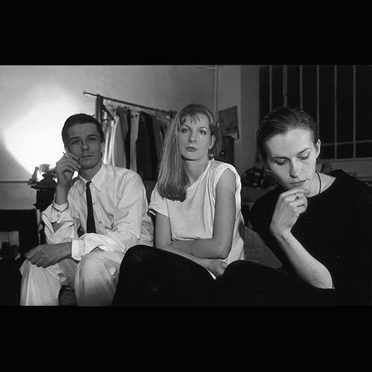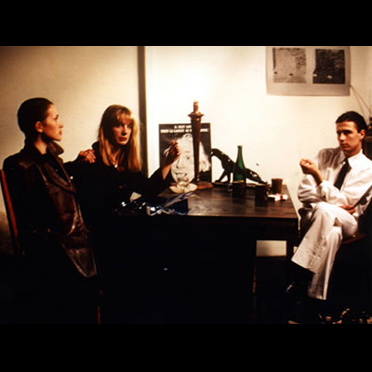Ruth
Ruth
It’s the early ‘80s, and Thierry Müller, a graphic artist and krautrock fan from Paris, has decided to put his experimental rock group Ilitch on hold and make something, as he puts it, “that people could dance to”. The result is Ruth, a conceptual project that exists for just one album, 1985’s Polaroïd/Roman/Photo. Seven tracks long, it is a remarkable piece of experimental but danceable new-wave, and nowhere more remarkable than the title track – an icy-cold cut of flickering synthesiser, taut guitar and jagged saxophone featuring disconsolate boy-girl vocals and the mechanical click-spool sound of a Polaroid camera.
Polaroïd/Roman/Photo is not a success. History has it that the record sells in the region of 50 copies, and before long, Müller’s interest has strayed elsewhere – his next project, recorded 1985, is an EP called Pile ou Face, recorded under the name Crash in homage to the JG Ballard novel of the same name.
But this is not the end for Ruth. By the year 2000, the track ‘Polaroïd/Roman/Photo’ has been rediscovered and is being recirculated by an international underground of collectors and music fans entranced by the early groups of France’s la vague froid – the movement that became known internationally as ‘cold wave’. Original copies of ‘Polaroïd/Roman/Photo’ are suddenly shifting on eBay for £300. The track reappears on compilations like 2004’s So Young And So Cold, a collection of obscure French post-punk compiled by Ivan Smagghe and Marc Collin of Nouvelle Vague. And a burgeoning culture of music blogs dig up what information there is on the project, which turns out to be precious little: a few details about Müller, whose diverse musical projects over the years make for a pretty tangled discography; Müller’s co-writer Philippe Doray, also an experimental musician of cult repute; and the group’s mysterious female vocalist Ruth Ellyeri, of which little information can be found.
It turns out there is a reason for this. Ruth Ellyeri does not, did never, exist. Cut out the letters, jumble them up and it becomes clear: Ruth Ellyeri is Thierry Muller. He was his own muse.
“Ruth was not really a person,” laughs Thierry Müller. “She was part of my schizophrenic personality. It was part of the concept of the record – this was to be a record for girls, not a record for men. Most of the songs are ‘relationship’ stories, which is an endless theme. But in this album, it is the girls that have the best roles – they are impertinent, impudent, insolent, brazen, funny, lovable… and loving.”
The track ‘Polaroïd/Roman/Photo’ got a recent airing on Angular Recording Company’s fine compilation of gloomy ‘80s synth sounds, Cold Waves And Minimal Electronics Vol 1, earlier this year. Now, to mark its 25th anniversary, Angular have primed the full album for rerelease on deluxe, limited edition scarlet vinyl with a 12-page book of lyrics and photos and downloadable bonus tracks. These days, Müller lives in Paris and continues to record experimental music under his Ilitch pseudonym. He is clearly amused that the music of Ruth has been rediscovered after all this time, and while his English is not excellent, he is pleased to relieve the life and times of Ruth with The Quietus.
When was it that you became aware that the ‘Polaroïd/Roman/Photo’ track had been rediscovered?
Thierry Müller: It begun around 2000 or 2001. I put my website online and started to receive many mails from everywhere in the world - people wanting to get a copy of the original LP, people saying that they heard it in disco and DJ sets. At the time it was really underground. It was not well distributed. It was completely crazy – I could never have imagined such a thing.
So what originally inspired you to create the Ruth project?
TM: There were some contemporary groups I liked, but it seemed to be always the same drum machines, the same arrangements. At this time I was more involved in underground and alternative music, more in the direction of Cabaret Voltaire, This Heat. But I had a feeling I would like to do something different to the things I was making – something more light than the music I was making in Illich, something that could be played at a discotheque.
What was the French underground music scene like in the early ‘80s?
TM: It was only in the early ‘80s that France began to look at what was happening in its own country, not just to England .It was the first years of Mitterand, and there was hope in the air. For young people, it was a chance for real change. 1981, for instance, was the beginning of official free radio. Before that, the only radio was commercial, but it suddenly felt like it would be possible to have a track that you made played on the air. There were a few fanzines and magazines that were starting to write about the French groups. The art scene was more creative, there was some new openings. And of course, the advent of cheap synthesisers had an huge artistic effect.
There were a lot of groups who were playing rock, punk, new wave, but only a few of them were well-known, the ones signed to major labels or one of a few alternative labels. Groups like Taxi Girl, Stinky Toys, Tokow Boys, Kas Product, Mathématiques Modernes, Jacno, Metal Boys, Artefact, Marquis de Sade – you might hear these on the radio, or find their records in shops. But you had to be really interested to have access to groups like Mary Möör, Nini Raviolette, End Of Data, The Neon Judgment. It is funny, now, to see all the compilations of groups from the ‘80s, because at the time I had never heard most of these groups. We were all isolated in our cities - it was not like this big village we live in now.
Was punk an inspiration? There’s a cover of Can’s ‘She Brings The Rain’ on the album, which suggests you were a fan of krautrock…
TM: I was more inspired by punk in life than in music. The English punk groups were a lot more interesting than the French. At this time, the Sex Pistols and groups like that, it felt like a really exciting movement - a reaction against society. I do like Can, it was the first cover of a Can title I had done, and it’s kind of a homage, really.
So who were the members of the Ruth band?
TM: It was not really a band! Most of the people who played on it were friends, the drummer was a friend, the horn players, friends… if I needed a horn part, I would call people up and say, can you do something on this? For the track Thriller, I did not know any violinists, and a friend said I know, a violinist. The only person who really got involved in the concept was Frédérique Lapierre, who wrote some lyrics on the album and sang on the first version of ‘Polaroïd’.
Did you ever play gigs?
TM: No, with Ruth, never. It would have involved a lot of people, and I never had a real group like that, with guitars, violins. I never found the people.
What is the lyric of ‘Roman Polaroïd Photo’ about?
TM: It is the story of a girl, and a boy who is infatuated with her. He is very romantic, but very timid, shy, and she is laughing. She is saying, if you want to play with me, you have to be playful. It is hard to translate into English, but it is full of wordplay.
Originally, the lyric was sung by Frédérique Lapierre, who wrote lyrics on the album and sung on other tracks. But her voice was too mellow for this mix. The well-known mix was sung by a friend of the sound engineer, and I saw her only for this take.
So how did the 25th Anniversary reissue on Angular Recording Company come about?
TM: I originally met Joe Daniel two or three years ago in Paris. He was looking for ‘Roman Polaroïd Photo’ in a shop in Paris called Bimbo Tower, which is run by a friend of mine, a really good shop. He asked me if I had other Ruth music. We spoke on the phone earlier this year around the time of the issue of the compilation, and we were talking about the album – it is not on iTunes or anything, and I said I was thinking it could be funny to put it out again like it was 25 years ago, as an LP, with a lovely cover, and a facsimile of the booklet. Because a lot of people ask about LPs, they don’t like CDs. [laughs]. And he said yes.
Is it strange, ‘Roman Polaroïd Photo’ having this new life?
TM: Yeah, it is really strange. It is a good track, I think - it still works. It has gone very far since it started showing up on compilations. I have DJs telling me, I love this, I played this, and at the time it was nothing, nothing. When I started Ruth, it felt like a project like this could exist in France – it felt like there was finally air to do things, that would could breath in a more artistic way. There was - but not as much as we hoped. France was still the country of our parents. But since the ‘80s, there has been a huge change in the culture and the politics, and it is much more easy to do things. Looking back, it was really a junction.
Text by: Louis Pattison. Reprinted from The Quietus.


